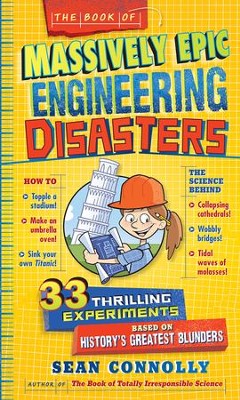
The Book of Massively Epic Engineering Disasters:
33 Thrilling Experiments Based on History's Greatest Blunders
by Sean Connolly
I wrote a blog post previously with my planning notes when doing this block on Zoom. Now I get to do it IRL with a group of students!
For each disaster I'll share my up-to-date notes and some photos. Today we learned about the deadly collapse of Fidenae Stadium (Ancient Rome, 27 CE)
- recall last week's disaster (The Colossus of Rhodes), test remaining designs
- discuss some of the engineering marvels the Romans were known for (roads, baths, arches, aquaducts, ampitheatres, etc.)
- read "Fidenae Stadium Collapses" information from The Book of Massively Epic Engineering Disasters, pp. 15-19
- do experiment #3 "From the Ground Up"
- for each team (set up three):
three chopsticks
bucket filled nearly to the top with sand (?)
ruler
six paperback books
This experiment has been challenging for me both times I've tried it. I would love to find a combination of materials that is more successful!
It calls for chopsticks. Both times I've used 1/4 inch bamboo dowels for knitting needles instead; perhaps chopsticks would be better because they are shorter (21 cm, 23 cm, 25 cm) and flare out a little at the bottom.
It calls for sand. I used sand the first time but substituted potting soil the second time because you have to pour the sand when you create the different foundation depths, and it's not good for children to inhale the dust from playground sand. So this one has me stumped. Is the sand important? Or does he just recommend sand because it's inexpensive? Is there a reason why you couldn't just do this experiment outside on/in the real ground?
It calls for modeling clay or play dough. We've tried play dough (too soft) and modeling beeswax (takes too long to warm up on a cold day). Plastilina turns out to be the best thing! It's strong but pliable at any temperature.

We have only been able to get it to support the weight of one book but given that the experiment calls for six paperback books or more, I am certain that there is more I can do to make this experiment a success. It was cool to see it twirl before it fell, though, since the children weren't expecting that!
One student suggested doing this experiment in reverse. Begin with the sticks buried deep and see how many books they will hold, then work your way up closer and closer to the surface and watch the number decrease. I think that's a really good idea!
- do experiment #4 "Weighing the Possibilities"
- for each team (set up three):
6 sheets of computer paper
tape dispenser
sharp pencil
Styrofoam coffee cup
small ball of string
pair of scissors
ruler
2 large paper clips
2 identical card table chairs
weights (pennies, marbles, glass gems, etc.)
note: before doing this experiment, it helps to have the team define "buckle"
important! whatever your definition of "buckle" is, it must stay consistent throughout the three rounds of the experiment
- pass out Science Club notebooks, have each child draw and write notes about his/her favorite experiment or about the disaster itself
I was so busy helping the teams with supplies and designs, and keeping track of everyone's data on the chalkboard, I forgot to take pictures of them working on their experiments! Oops! But we all had a great time. Next week: The Leaning Tower of Pisa!
This post contains affiliate links to materials I truly use for homeschooling. Qualifying purchases provide me with revenue. Thank you for your support!






 Immersive Experience
Immersive Experience Immersive Experience
Immersive Experience







No comments:
Post a Comment